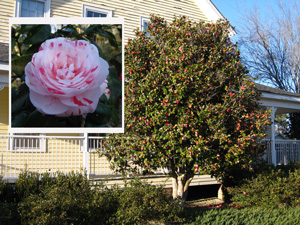Resource Library
Plant of the Week: Japanese Camellia
The University of Arkansas System Division of Agriculture does not promote, support or recommend plants featured in "Plant of the Week." Please consult your local Extension office for plants suitable for your region.
Plant of the Week
Japanese Camellia
Latin: Camellia japonica

Lust is supposed to be one of the sins, but some gardeners can't help themselves. I too am afflicted with this malady, and every time I head into warmer climes, my longings to grow some of these more tender beauties in my own garden resurfaces. Japanese camellia (Camellia japonica) is too tender for those of us that garden in the northern part of Arkansas, but that doesn't keep us from lusting.
This camellia is a big rounded, low-branched evergreen shrub growing 12 to 15 feet tall with a spread of 8 to 10 feet. It has thick, ovate, deep green evergreen leaves 2 to 4 inches long. Over 100 species of Camellias have been described, with the center of distribution in southwestern China between the Himalayans and tropical areas of East Asia. The genus belongs to the tea family, with tea leaves harvested from a related species, C. sinensis.
The base color of camellia flowers is carmine red, but color variants have been described in China since at least the 11th century. Flowers burst open from large, overwintering buds and appear in the spring over a long period in shades of red, pink, white and bicolor. Blooms may be single, with numerous prominent yellow stamens in the center or, more commonly, many times doubled to create the “anemone” flowered hybrids. Flowers are non-fragrant and range in size from 3 to 5 inches in diameter.
Camellia japonica has a bit of an identity crisis. In China, where this camellia is grown in almost every garden and temple site, the plant is called ch'a hua (tea flower) or shan ch'a (mountain tea). In northern areas, where it is not hardy, it is grown in containers and taken in during the winter. Because it blooms in late winter, it is associated with the Chinese New Year festivities.
The name camellia is a Latinized version of the name of a Jesuit Priest, Josef Kamel (1661 - 1706) who contributed an account of the native plants of the Philippines, which was published in English in 1703. The epitaph credits Japan, not China, as its home because of an account published by Englebert Kaempfer, a German botanist who visited the island nation in the early 1700s and published a detailed report in 1712.
The first living plants of camellia were in England by 1739, where the plant was grown as a conservatory plant in an estate greenhouse. This early introduction didn't excite a lot of attention, but the second introduction in 1790 spurred more interest. By 1815, a dozen clones were being grown and shared amongst the conservatories of rich European estate owners. By about this time, camellia breeding efforts begun in earnest; the first book on camellia cultivation appeared in 1819. The first mention of camellias in the United States appeared in 1798. By 1833, at least 50 cultivars were available from nurseries, where they found a ready acceptance in the gardens of the Old South.
Japanese camellia is reliably hardy from zone 7 through 9, but by trial and error it is possible to identify some selections that will grow farther north in zone 6b (hardy to about -5 degrees F). Camellias, because they are so large, are usually used as a part of the background screening for gardens and as specimen plants along walkways. If hardiness is likely to be a problem, locate the plants on the south or east side of the house.
Camellias do best with a uniformly moist, highly organic soil that is well drained. Best blooms are produced in full sun or light shade. They tolerate shearing well, but it is difficult to keep plants less than 6 to 8 feet tall without ruining their effectiveness in the landscape. Scale insects are sometimes a problem pest, especially in milder parts of the country.
By: Gerald Klingaman, retired
Extension Horticulturist - Ornamentals
Extension News - February 18, 2011
The University of Arkansas System Division of Agriculture does not maintain lists of retail outlets where these plants can be purchased. Please check your local nursery or other retail outlets to ask about the availability of these plants for your growing area.